Timeline of Sri Lanka’s civil war
Recent peace talks failed to bring an end to 23 years of civil war in Sri Lanka that has now claimed over 65,000 lives.

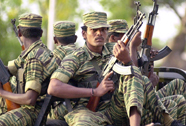 |
|
The LTTE was formed in 1976 |
Recent peace talks failed to bring an end to a 23 year civil war in Sri Lanka that has now claimed over 65,000 lives. Here are the main events in the conflict.
1948 Ceylon gains independence from British rule dating back to the end of the 18th century.
The population is comprised of a Sinhalese majority that can be traced back to the sixth century BC and a Tamil minority, mainly concentrated in the north of the country who have roots as far back as the third century.
1956 Sinhalese is made the only official language in a series of Sinhalese nationalist measures introduced by the government
1958 Riots erupt between the Sinhalese and Tamil communities that leave many people dead and force several thousand people, mainly Tamils to relocate to the north
1972 The country is renamed Sri Lanka
The Tamil New Movement is formed by V. Prabhakaran, made up mainly of university students calling for greater equality in the grading system and more places in the higher education system. In 1975 they assassinate the mayor of Jaffna, marking the emergence of violence in the Tamil campaign.
1976 The Liberation Tigers of Tamil Eelam (LTTE) are formed when the Tamil New Movement joins another Tamil group.
The concept for a separate Tamil state (Tamil Eelam) to be established in the north of the country is first proposed by the Tamil United Liberation Front (TULF).
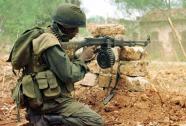 |
|
Both sides have sustained heavy losses |
1977 The TULF, a coalition of small parties, wins the majority of seats in Tamil areas in the country’s elections but the government later bans them from parliament for advocating an independent state.
More riots break out following an alleged assault by Tamils on Sinhalese policemen.
1983 Ethnic tensions in the country erupt into the start of a civil war when 13 soldiers are killed in an LTTE attack sparking anti-Tamil riots in Colombo and other parts of the country that leave thousands of people dead and force Tamils to leave Sinhalese majority areas.
1985 The first attempt at peace talks between the two sides fails.
1987 Government soldiers push LTTE fighters back to the northern city of Jaffna.
In the same year the LTTE carries out what is believed to be its first suicide attack when a truck is driven into an army camp and explodes killing 40 soldiers.
The government signs the Indo-Sri Lanka peace accords that makes several concessions to the Tamil fighters, including recognising Tamil as an official language. India agrees to help keep order in the north and east of the country via a peace-keeping force and agrees to stop helping Tamil fighters.
1988 Indian troops leave the country as violence escalates between the warring parties.
1991 The former Indian prime minister, Rajiv Gandhi is assassinated by a suicide bomber who is believed to be a member of the LTTE.
One of the war’s fiercest battles takes place at the Elephant Pass army base that controls access to the Jaffna peninsula. Thousands of LTTE fighters surround the base and lay siege to it for a month in a battle that leaves around two thousand dead on both sides.
1993 The Sri Lanka president, Ranasinghe Premadasa is killed by an LTTE bomber.
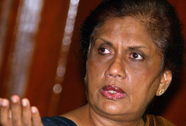 |
|
Kuramatunga was president for 11 years |
1994 New president, Chandrika Kumaratunga, opens peace talks with the LTTE.
1995 The peace talks collapse and the government launches a major offensive that drives the separatists out of Jaffna. An estimated 400,000 civilians leave the town.
1996 Government troops launch another offensive and further 200,00 people flee the violence.
90 people are killed and 1,400 injured when a LTTE suicide bomber attacks the central bank in Colombo. The government imposes a state of emergency.
1997 A separatist bomb attack damages the Temple of the Tooth in Kandy, the country’s holiest Buddhist site.
The government and some foreign administrations ban the LTTE in an effort to disrupt their fundraising.
1999 Kumaratunga loses one eye and sustains other injuries in a failed assassination attempt by the LTTE at an election rally.
2000 Norway offers to act as mediator in peace talks. Human rights groups estimate that more than one million Sri Lankans are internally displaced people.
2001 Ranil Wickremasinghe becomes prime minister on a pro-peace platform.
2002
February A ceasefire is agreed in with Norway and other countries agreeing to monitor it through the Sri Lanka Monitoring Mission.
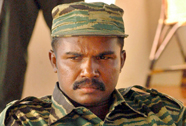 |
|
Renegade general Karuna has fractured the LTTE |
March Transport links are re-opened to Jaffna and in the Vanni region controlled by the separatists. Decommissioning of weapons also starts.
September The government agrees to lift the ban on the LTTE.
December At peace talks in Norway the two sides agree a power-sharing deal that would establish an autonomous Tamil-speaking region in the north and west of the country.
2003 April The Tigers walk out of peace talks.
2004
March The LTTE begins to fracture when a Tiger commander, General Karuna, pulls 5,000 fighters out of the LTTE saying insufficient resources are being given to Tamils in the east of the country.
April General elections are held early and the party of president Kumaratunga is unable to secure an overall majority in parliament and Mahinda Rajapakse becomes prime minister.
December Over 30,000 Sri Lankans are killed and tens of thousands left homeless by the Indian Ocean Tsunami. Arguments ensue almost immediately about whether the large amount of international aid is sent to mainly Tamil or Sinhalese areas.
2005
July A deal is reached to distribute around $3 billion in aid among Tamils, Sinhalese and Muslims but the Sinhalese nationalist JVP party pulls out of the governing coalition in protest.
 |
|
Rajapakse’s presidency has seen an increase in violence |
August The foreign minister, Lakshaman Kadirgamar, an ethnic Tamil and staunch critic of the LTTE is killed by a sniper.
November Rajapakse wins the presidential election after many Tamils do not vote. He is seen as more of a hardliner but promises to pursue talks with the LTTE.
December The Tamil Tigers launch their first major attack since the truce killing at leats 12 Sri Lankan navy personnel. A series of attacks follow.
2006
February During peace talks in Geneva the government and the Tigers say they still have respect for the 2002 ceasefire and pledge to reduce the recent high level of violence.
April 21 The second round of peace talks are postponed as violence increases again. Coordinated rioting in the northeastern town of Trincomalee leaves 16 people dead.
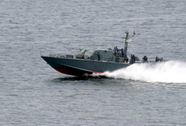 |
|
Sea battles have been a common feature of the war |
April 25 A suicide bombing aimed at killing the government’s military commander in Colombo leaves eight people dead and is blamed on the Tamil Tigers. The government responds by launching air attacks on Tiger bases.
May 11 Tamil Tiger boats sink a navy patrol boat killing at least 17 sailors. Five Tiger ships are sunk during the battle that kills 50 LTTE fighters.
May 29 The EU blacklists the LTTE as a terrorist organisation.
June 15 At least 61 people are killed in a mine attack on a bus full with commuters and schoolchildren prompting government air strikes.
July 4 President Rajapakse denies that renegade Tamil Tigers are operating in army-held territory and says he wants to find a solution to the conflict with the rebels.
July 29 Finland and Denmark announced that their truce observers would leave the country because of the increasing violence.
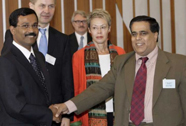 |
|
Peace talks in Geneva made no progress |
August The worst fighting since the 2002 ceasefire leaves hundreds of people dead and thousands displaced.
The UN threatens to suspend aid operations in Sri Lanka after international truce monitors accuse the country’s military of killing 17 aid workers.
September 4 The Sri Lankan army captures the strategic town of Sampur near Trincomalee.
September 25 A fierce sea battle leaves 70 separatist fighters dead.
October 3 The Tamil Tigers say they have banned agreed to peace talks later in the month.
October 16 Up to 100 people are killed in an apparent LTTE suicide attack on a naval convoy, some civilians are among the dead.
October 29 Peace talks in Geneva fail to make any experience and hostilities resume between the two sides the next day.